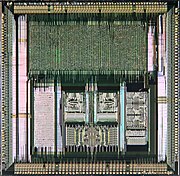Carver Mead
| Carver Mead | |
|---|---|
|
Carver Mead in 2002
|
|
| Born |
May 1, 1934 Bakersfield, California |
| Nationality | American |
| Thesis | Transistor Switching Analysis (1960) |
| Doctoral advisor |
R. D. Middlebrook Robert V. Langmuir |
| Notable awards |
National Medal of Technology 2011 BBVA Foundation Frontiers of Knowledge Award Computer History Museum Fellow (2002) |
 |
|
|
|
|
|
|
|
|
|
Carver Andress Mead (born 1 May 1934) is a US scientist and engineer. He currently holds the position of Gordon and Betty Moore Professor Emeritus of Engineering and Applied Science at the California Institute of Technology (Caltech), having taught there for over 40 years. Mead is an enthusiastic instructor, and he advised the first female electrical engineering student at Caltech, Louise Kirkbride. His contributions as a teacher include the classic textbook Introduction to VLSI Design (1980), which he coauthored with Lynn Conway.
A pioneer of modern microelectronics, he has made contributions to the development and design of semiconductors, digital chips, and silicon compilers, technologies which form the foundations of modern very-large-scale integration chip design. In the 1980s, he focused on electronic modelling of human neurology and biology, creating "neuromorphic electronic systems." Mead has been involved in the founding of more than 20 companies. Most recently, he has called for the reconceptualization of modern physics, revisiting the theoretical debates of Niels Bohr, Albert Einstein and others in light of later experiments and developments in instrumentation.
Carver Andress Mead was born in Bakersfield, California and grew up in Kernville, California. His father worked in a power plant at the Big Creek Hydroelectric Project, owned by Southern California Edison Company. Carver attended a tiny local school for some years, then moved to Fresno, California to live with his grandmother so that he could attend a larger high school. He became interested in electricity and electronics while very young, seeing the work at the power plant, experimenting with electrical equipment, qualifying for an amateur radio license and in high school working at local radio stations.
...
Wikipedia
